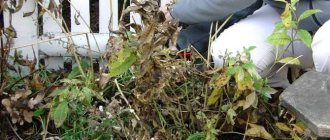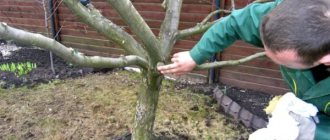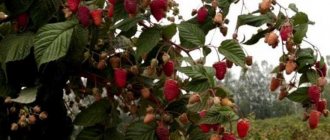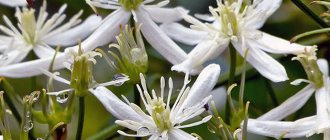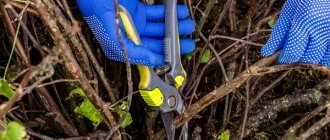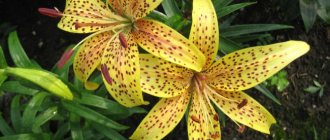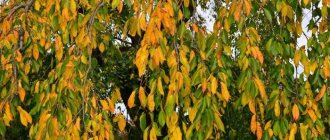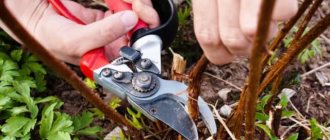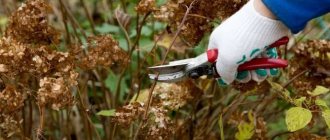Winter time is a difficult period for trees.
Winds, frosts, heavy wet snow, freezing rains - the apple tree must endure all this with minimal losses.
In the fall, after the last fruits have been collected from the apple trees, the tree begins to prepare for winter.
The task of every gardener is to help him with this. If we carry out a number of comprehensive activities in the fall, then in the spring the apple orchard will thank us. Only in a well-kept garden do apple trees get sick less and bear fruit every year.
How to care for an apple tree in the fall?
There is a whole range of activities included in the care of apple trees in the fall, which must be carried out after harvesting, but before frost occurs. It includes:
- Removing fallen leaves and digging up the soil;
- Application of fertilizers;
- Moisture-recharging irrigation;
- Mulching tree trunk circles;
- Removing moss and lichens, stripping bark;
- Branch pruning;
- Whitewashing trunks;
- Treatment against diseases and pests;
- Warming apple trees.
Each stage of this work is important for the apple orchard. If tree care is carried out regularly , then some points can be skipped.
If the garden has become desolate, the trees are sick, and the apples are small and sick, then we urgently get to work. Autumn is the best time for this.
Barrel processing
One of the important stages of work is the correct preparation of the barrel. There are several different procedures here that together will act as excellent preparation for the cold weather.
Removing moss and lichens
Moss and lichens themselves do not harm the apple tree; they are absolutely calm and safe cohabitants. However, in large quantities, moss or lichen quickly and tightly entwines the trunk of the apple tree, and because of it, the plant does not receive enough oxygen, as a result of which the branches dry out. They can also move quite quickly to neighboring crops in the garden.
This is what lichens look like on an apple tree.
Lichens and mosses should be removed carefully with plastic spatulas so as not to damage the bark itself. After the cleaning process, you need to disinfect with a solution of copper or iron sulfate. After a few days, when the trunk dries, it needs to be treated with garden varnish.
To destroy growths from a plant without resorting to a rough physical cleaning process, a special composition is prepared. To prepare, you need to take slaked lime and clay in equal proportions, dilute with water and mix thoroughly. The consistency should be similar to thick sour cream. This mixture should be applied to the area where the lichen appears and left to dry. After drying, you can very easily comb it with a regular brush.
Control of harmful insects
If you leave the larvae and adults of harmful insects for the winter, they will find themselves a secluded place where they can survive the cold. It is very important to carefully examine the apple tree and check all the secluded places. Especially often they find a place for themselves under old areas of the bark. If such a home for the pest is found, then it must be removed along with the insects. It is necessary to carry out protective spraying with insecticides. It could be Karbofos or Aktara.
Pruning branches
Sanitary pruning is always carried out in the fall. To do this, it is necessary to remove broken, diseased, dry branches from the crown, as well as those that grow deeper. The pruning procedure should only be carried out in warm, dry weather. Cut the shoots with a sharp tool so that the cut areas are even and smooth. If there are large wounds or cuts, they must be sprayed with copper sulfate and covered with garden varnish.
Scheme for correct pruning of an apple tree in the fall.
Whitewashing the stamp
Apple tree trunks are whitened in winter to achieve two goals. The first is mandatory protection from the bright winter sun. In conditions when the winter is snowy and the sun is hot, a layer of whitewash will guarantee that the apple tree will not get frost damage.
The second point why you need to whitewash the trunk is to protect it from hungry rodents who love to feast on the bark, especially of young trees.
In order to carry out the procedure, you need to make a mixture of lime and water, add a little wood glue and copper sulfate to it. Some gardeners do not prepare the glue themselves, but purchase ready-made compositions for whitewashing.
Removing fallen leaves and digging up the soil
Fallen leaves protect tree roots from freezing in winter , retain moisture in the soil, the bottom layer rots and is an additional fertilizer. This is correct, but not for fruit trees.
ATTENTION: Many tiny spores of fungal diseases remain on fallen leaves. If the foliage is left under the trees, they will overwinter there just fine. When the warm and wet spring arrives, the spores will begin to multiply. The apple tree will get sick again, and we will have to take additional measures to combat diseases.
Leaf harvesting is carried out after the end of leaf fall. Foliage is burned only if the tree was very sick this year. If the tree is healthy or the disease was prevented at an early stage, then the collected leaves can be placed in a compost heap.
The compost ripening period is 2–3 years. The temperature in the compost heap is high, about 50°. Fungal spores die by the time the compost matures. When laying fallen leaves, you can treat them with fungicides.
Collection of leaves.
After collecting the leaves, you should dig up the soil in the tree trunk circles. The depth should be no more than 15 cm. When digging deeply, there is a risk of damaging the roots of the tree.
Why digging is necessary:
- Pest larvae hide in the soil. If the layers of earth are turned over, the pests will end up on the surface and die at sub-zero temperatures;
- The seeds of some weeds lose their viability when exposed to frost;
to dig up the soil when it is slightly damp. It is advisable to select the roots of perennial weeds that come across during digging.
TIP: Digging of tree trunk circles can be combined with autumn fertilization .
Removing garbage and digging up the tree trunks of apple trees
At the initial stage of preparing trees for wintering, you will have to collect debris, leaves and dig up the tree trunk. In autumn, the apple tree actively sheds its leaves, so it must be collected. The fact is that litter can be a breeding ground for infections or a place where pests have taken root. Is it worth leaving such foliage near the tree? Of course, it must be destroyed. This can be done by burning. Never throw away the resulting ash, because it is considered a source of potassium and other important trace elements.
Autumn care
Collect branches and rotted fallen fruit in a trash container. If the branch is too large, burn it to create wood ash.
As soon as you finish cleaning the tree trunk circle, start digging it up. Hold the shovel not across, but along the roots. Do not bury it more than 15 cm into the ground. After digging, leave the ground loosened. This way you will be able to destroy the pests that have accumulated in the tree trunk circle.
Related article:
Ways to protect an apple tree from rodents
Autumn feeding
vary on when to fertilize apple trees Some people add them immediately after harvesting, in August and September. Others believe that it is better to do this after the leaves have fallen. Both opinions are correct.
When choosing the time to fertilize, you should take into account that the tree will need about three weeks to absorb the fertilizer.
In order for the apple tree to receive useful substances before freezing, you need to rely on a preliminary weather forecast.
The main autumn fertilizer is organic matter.
Rotted manure or compost is applied at the rate of 1-2 buckets per tree.
At the same time, add 50 grams of superphosphate and 30 grams of potassium chloride per apple tree.
IMPORTANT: Nitrogen is not applied in the fall. The amount contained in organic fertilizer is sufficient in the autumn. Excess nitrogen can cause the growth of weak young shoots that freeze in winter.
Fertilizing is carried out simultaneously with digging up the top layer of soil. If fertilizers are applied at the beginning of autumn, they are incorporated into the soil with a rake.
In dry weather, the tree trunk circle is shed with water so that nutrients quickly reach the roots.
Features of autumn care
To prevent the tree from getting sick and dying from exposure to cold, wet snow, strong gusts of wind and freezing rain, carry out a series of works in the fall to prepare it for the cold season. Seasonal care for an apple tree includes cleaning leaves, digging the soil, fertilizing, watering, mulching, removing moss and lichen, pruning branches, whitewashing and insulation.
Removing fallen leaves and digging up the soil
In autumn, leaves fall from the trees abundantly and fill everything around. Gardeners do not remove before snow falls; they believe that it will protect the root system from the cold and retain moisture in the soil. In fact, you should not leave it, as parasites, spores and fungal diseases accumulate in it. In the spring they will begin to actively reproduce, and the plant crop will begin to get sick and wither. Remove leaves for the winter like this:
- Wait until the leaf fall ends.
- Rake up any foliage that has accumulated around the base of the tree.
- If the fallen plants were healthy, transfer them to the compost pile. If it hurts, move it to a distant place and burn it.
After the soil is cleared, experienced gardeners dig up the soil in tree trunk circles. Treat the surface layer so that the shovel penetrates to a depth of no more than 15 cm. This measure is necessary to eliminate pest larvae hiding in the soil and improve the supply of oxygen to the soil.
Fertilizer
The purpose of feeding is to provide the plant with nutrition and essential minerals. You can do it in any autumn period - at the end of August, in September or after the leaves have fallen. Do this no later than 3 weeks before the onset of frost or snow, so that the apple tree has time to become saturated with useful substances.
Use organic fertilizer for this purpose; rotted manure or compost work well. Pre-prepare it by adding 50 g of superphosphate and 30 g of potassium chloride to 2 buckets of organic fertilizer. This is enough to fertilize one tree. You can combine the application of nutrients with digging up the top layer of soil before winter.
On a note!
Some gardeners additionally add nitrogen to the composition. This cannot be done; due to its excess, weak young shoots will appear on the plant, and with the onset of frost they will freeze.
Watering
An important part of autumn and winter care is watering. It is needed to maintain moisture in the soil, so it makes sense to carry it out only during rare natural precipitation. Do a simple test - dig a hole at a distance of 15-20 cm from the soil surface and assess the condition of the soil. If it is moist and dense, it does not need watering. Irrigate loose and crumbly soil with liquid at room temperature.
Mulching
At the end of October - beginning of November, you need to mulch the soil. This is necessary to retain moisture in the soil, improve air permeability, protect the root system from temperature changes and provide additional nutrition to the soil. Good for this:
- peat;
- humus;
- sawdust;
- wood;
- dried mown grass.
The soil should be mulched to a layer of 10 to 15 cm; first dig up the surface layer. Choose the type of mulch depending on the composition of the soil; if it is acidic, then sawdust or shredded wood will do. It is better to lay peat and humus on top of the alkaline soil.
Removing moss and lichens, stripping bark
The obligatory process of treating an apple tree in the fall is the removal of moss, lichen, and surface stripping of the bark. It is especially necessary to carry it out on the trunks of those trees that have been exposed to moisture for a long time or are located in neglected gardens. Due to the surface layer, the holes in the bark are blocked. Therefore, the plant does not receive the required amount of oxygen, which leads to drying of the branches. A tree may die from severe lichen infestation. To prevent this from happening, free the trunk from moss like this:
- Fill a bucket with 10 liters of water.
- Dilute 300 g of iron sulfate in it.
- Treat the trunk, branches and soil around the trunk with the resulting solution.
Immediately after the treatment, the lichen will begin to dry out; after 10 days it needs to be cleaned with a stiff brush and the residue removed. A similar procedure can be performed with copper sulfate; to do this, dilute 500 g of powder in a bucket of water.
On a note!
To facilitate subsequent work, it is recommended to lay thick material under the tree. After processing, all that remains is to collect it together with dead tree bark and dispose of it.
Trimming
Autumn apple tree care always includes sanitary pruning. 2 weeks before frost. Remove all dead and diseased branches, taking a little of the healthy wood to speed up the healing of the cuts. Treat open areas with garden varnish. This is necessary so that the plant spends less energy on them and directs all its energy to the growth of new shoots.
Whitewash
If you properly care for your apple tree in the fall, during the winter it will not acquire new diseases and will not weaken, therefore, it will begin to bloom and fill with fruits in time. The formation of cracks in trunks due to temperature changes can significantly affect its full development. To prevent this, whitewash the trunk. Use paint or any special solution for this, spreading it with a brush around the trunk at the base to the distance where the first branch begins or to the height of an outstretched arm if the tree is mature. Please keep a few important points in mind:
- You can care for the apple tree strictly on a dry day;
- by this time the air temperature should not fall below 3 degrees Celsius;
- You need to paint not only the trunk, but also the skeletal branches.
In addition to preventing the formation of cracks, whitewashing will also protect the plant from sunburn and pest damage. If it rains immediately after the procedure, most of the paint will be washed off, so it will be necessary to redo it.
Treatment against diseases and pests
Additionally, it may be necessary to treat apple trees for pests in the fall if they were noticed on leaves and branches in the summer or the tree was infected with a fungal disease. Wait until the foliage has completely fallen from the apple tree, then treat the plant crop with any solution suitable for it. If pruning, stripping of bark and removal of lichens have already been done in the fall, then this treatment is not necessary.
Insulation
Only those apple trees that are under 7-8 years old need to be insulated. As a protective cover for the root system, use:
- any mulch;
- bast shoes of coniferous plants;
- foliage from trees that have not been susceptible to disease and pests;
- sawdust;
- stalks of corn or sunflower.
Cover young seedlings with additional non-woven material and carefully tie it so that the rope does not compress the branches too much. To protect against the cold and rodents, you can also use thick sheets of cardboard, paper or burlap. Place the shelter around the trunk at a height of 1-1.2 meters. In the same way, you can make a fence from the branches of coniferous plants. In the spring, this cover must be removed.
Watering apple trees in autumn
Autumn watering is called moisture-recharging. Whether to carry it out or not depends on the weather. If it rains consistently well in the fall, there is no need to water. If the rains are rare and drizzling, then the apple trees need to be given water for the winter.
Watering apple trees in the fall.
check the need for watering as follows: dig a hole 15–20 cm deep under the tree. If the soil at the bottom is wet and does not crumble when compressed, you should not water it. In other cases, watering is required.
IMPORTANT: Trunks and branches saturated with water break less from the wind, withstand the weight of snow, and their bark is resistant to frost. A connection has also been noticed - the more you water the apple tree in the fall, the more fruit ovaries there will be in the spring.
A young tree will need 3 buckets of water, for an adult - about 6. The ground should be saturated to at least 0.5 meters. Apple trees on dwarf or semi-dwarf rootstocks require less moisture than tall trees.
Technology
The principle of “taking a bucket and watering” for an apple tree is perhaps a bit rude, although it has a right to exist, just like watering from a garden hose. In addition to these methods, there are three more worthy of attention:
- Subsoil irrigation - with this method, water is supplied directly to the roots, providing them with the necessary supply of moisture for a long time.
- Drip irrigation - used on infertile soils. Water is supplied to the root of the tree. With this type of watering, the paths in the garden remain dry and there is no need to drag the hose. The number of weeds is reduced.
- Sprinkling is recognized as the best way to water a site, in which the soil is moistened evenly. You have the opportunity to control water consumption and regulate the amount of watering. It is used at sunset or after sunset. In cloudy weather it is possible during the day.
Photo gallery of watering methods
Drip irrigation is best for infertile soils
Subsoil irrigation helps maintain moisture at the roots
Sprinkling is the best way to evenly saturate the watered area with moisture.
If the apple tree is on a slope, you can create a river and a bowl from the ground using earthen rollers. In this case, the water will get exactly where the roots are and will not flow down the slope.
Pre-winter watering is carried out daily for a week, and each time it takes two buckets of water.
With proper watering, the soil is saturated to a depth of half a meter. In order to retain moisture in it, two days after, mulch with humus, sawdust and sand. The layer can reach a thickness of 5 cm.
Moisture-recharging irrigation involves carrying out during leaf fall or immediately after its end, and therefore residents of different regions should take into account not only the timing of the onset of cold weather, but also the characteristics of a particular variety.
When planting apple trees, watering is mandatory, even if the weather is rainy that day.
Planted apple trees are watered regardless of the weather
Mulching
Mulching around tree trunks keeps the soil moist longer and makes it breathable.
In addition, mulch is a long-lasting fertilizer. Over time, it rots, and additional nutrients enter the soil.
In winter, mulch protects the ground from differences in night and day temperatures and serves as an insulating material.
Peat, humus, sawdust, and dried mown grass are suitable for mulching. The layer should be from 10 to 15 cm.
If the soil on the site is acidic , then it is better to mulch it with sawdust and chopped wood.
If the soil is alkaline , then peat, humus, and pine litter are suitable. Compost, straw, fallen leaves from ornamental trees are suitable for any type of soil.
Useful video:
Watch the video on how to deal with moss on fruit trees:
How to save tree bark. Autumn treatment:
Remove moss and lichens after leaves fall. Two methods have worked well :
- The tree trunk is treated with iron sulfate. To do this, 300 grams are diluted in 10 liters of water. The trunks, branches and ground under the tree are processed. After 10 days, the lichens die off. They are cleaned with a stiff brush. You need to spread a cloth under the apple tree so that the fallen spores do not fall on the ground.
- Moss and lichen are first cleaned from the trunk, and then treated with copper sulfate. 500 grams of powder are diluted in a bucket of water. The soil in the tree trunk circle is also sprayed.
The video will tell you how to use iron sulfate:
Once every 3–4 years in the fall, it is necessary to clear the old bark from the trunks , even if there are no lichens on it.
ATTENTION: Pests overwinter under the old bark, where they lay their larvae. Pathogens can also hide under the bark and wait for favorable conditions to attack the tree.
Clean the bark with a scraper or stiff brush. The ground under the tree is covered with a cloth so that pieces of bark do not remain on the ground.
The crumbled bark particles are burned.
Pruning branches in autumn
In autumn, it is advisable to carry out only sanitary pruning of apple trees. Remove dried and diseased branches.
The cutting is carried out by slightly capturing healthy wood. This is the only way the cut will heal evenly, and the bark will not crack or bulge. The sections are cleaned and treated with garden varnish.
If you decide to carry out regulatory pruning in the fall , then it is better to do this when the leaves have completely fallen off.
About two weeks should pass from the pruning date to the onset of frost.
TIP: When pruning, it is important to use only sharp tools. This will allow you to get an even cut that will heal quickly .
Whitewashing trunks
Whitewashing of trunks is carried out after removing mosses and lichens, after stripping the bark and trimming dry branches.
Whitewashing has several purposes:
- Prevent cracking of trunks, which occurs when there are differences between day and night frosts;
- Protects against sunburn;
- Prevents pests from hiding under the bark for wintering;
- Whitened apple trees are less likely to be gnawed by mice and hares.
For whitewashing, you need to choose a dry day. If it rains immediately after the procedure, it will wash off all the paint. It takes several hours to dry.
IMPORTANT: At temperatures below 3°, whitewashing of apple trees is not carried out. Young trees are covered with paint up to the point where the first branch begins. Mature apple trees are whitened to arm's length. It is advisable to paint the trunk and all skeletal branches.
Preparing apple trees for winter: Autumn whitewashing
You can often see gardeners bleaching trunks in the spring. Apart from aesthetic pleasure, such whitewashing gives nothing, because its main purpose —
protect the bark from sunburn and cracking in frosty weather.
You need to take care of your apple tree in the fall .
Another purpose of whitewashing is
protection from pests, so copper sulfate is often added to the whitewash mixture. For 10 liters of water take 2.6 kg of lime, 0.6 kg of vitriol and 250 g of carpentry or casein glue.
Interesting! When preparing young apple trees for winter, lime is partially replaced with chalk, and glue with milk. Whitewashing is carried out in dry weather from the bottom up to the first fork of the branches.
Treatment against diseases and pests
Autumn treatment with pesticides is only necessary if there was a massive pest invasion in the summer or the tree is heavily infected with fungal diseases. In this case, the treatment is carried out after the apple tree has completely shed all its foliage.
Pest control.
If the tree has not been sick this year , the bark has been stripped, treated to remove mosses and lichens, and autumn whitewashing has been carried out, then there is no need for spraying against diseases and pests.
Common errors and violations
When carrying out manipulations to prepare apple trees for the winter season in the fall, experienced gardeners rarely make mistakes. But, in cases of lack of information, little experience in caring for fruit crops, or incorrect calculation of the timing of work due to weather conditions, they are possible. The following are common problems that arise due to violation of the norms for the autumn preparation of apple trees:
May be interesting Features of treating an apple tree in the spring from pests and diseases How to properly prune a columnar apple tree in the fall How to properly plant an apple tree in the spring: tips for beginners
- Freezing of the edges of the main and side shoots of the tree occurs due to late pruning. If there is little time left before the first frost, the sap that should cover the cut site freezes and damages the branch.
- The active development of parasites and various bacterial and fungal diseases is often a consequence of uncollected leaf litter. Some insects and nymphs hide in the foliage during the cold season, and decay leads to the development of provocateurs of tree diseases.
- Freezing of buds and branches of young and adult apple trees due to lack of shelter at the beginning of the winter season in cold regions. Young branches cannot withstand a serious drop in temperature, especially in the northern zone of Russia.
- The constant presence of parasites, which can be caused by the presence of damaged parts of the bark or branches. Any cavities on the plant can become a haven for pests and their larvae, so such places must be trimmed or cleaned.
- The root system often freezes, which leads to the death of the fruit tree completely. This is caused by abundant watering in the period before the onset of severe frosts.
On a note!
The use of nitrogenous fertilizers often leads to the fact that sap flow in the tree does not slow down, and the buds remain active. This disruption of the natural preparation of a fruit crop for frost also often leads to its death.
Autumn pre-winter preparation of an apple tree is one of the ways to prevent diseases of this plant and pests. If everything is done according to the standards, then in the spring season there will be no need to carry out additional spraying of the tree with various chemicals, and the fruits will be of high quality. But, for the successful completion of such activities, it is necessary to take into account weather conditions, regional climatic features and differences in caring for an old plant and a recently planted one.
Warming an apple tree as an element of care in the fall
Insulation of roots and trunks is necessary for young apple trees up to 7–8 years old. It is especially important during snowless winters with a large difference in day and night temperatures.
If a layer of mulch is poured into the circle under the apple tree, it will protect the roots from frost. An apple tree on a dwarf or semi-dwarf rootstock will require additional shelter. They will use corn stalks, straw, sunflowers. You can use non-woven covering material. In the spring it must be removed in a timely manner. .
Young trunks of apple trees are wrapped not only for insulation, but also for protection from rodents .
To do this, you can use cardboard, several layers of thick paper, burlap, and branches of coniferous trees.
Insulation should end at a height of 1 - 1.2 meters from the ground. Remove it in the spring, when the snow has completely melted.
How to insulate an apple tree for the winter?
In the conditions of the Middle Zone, only young trees require insulation, especially those planted this year. Natural burlap can be used as a covering material. The trunk is wrapped after whitewashing and installation of a protective mesh. Wrap the trunk to the base of the skeletal branches.
Some gardeners successfully practice insulation with old newspapers; they wrap the trunk with them and use tape to secure the paper. A good protection for seedlings is spruce spruce branches, reeds, and you can also use roofing material.
The tree trunk area can be covered with several layers of burlap or matting. You can cover it with a 2-4 cm layer of humus. This is a good insulation material that will serve as organic fertilizer in the spring.
If you use sawdust, then their layer should reach 20 cm. After the snow has melted, the sawdust should be removed, because they will interfere with the heating of the soil.
For insulation and protection from sunlight and rodents, you can use breathable fabrics, including spunboard. The material is attached to the trunk with twine or tape. The bottom edge of the fabric should remain on the surface of the ground; it will need to be covered with earth. In this case, trees do not need to be whitened for the winter.
Caring for apple trees in August - September
In August - September, the time comes for the apple orchard to take care of preserving the harvest. Strong supports are placed under heavy branches strewn with fruits. A branch broken from weight is a disaster for any apple tree. Sometimes the fracture site is so deep that the apple tree cannot be saved.
The second task of the gardener is to collect carrion every day. Apples that fall off prematurely are rarely healthy. If they are sick or damaged by pests, they should be taken out of the area and buried.
Three weeks before the full harvest, it is necessary to water the trees at the rate of 4 - 5 buckets per tree.
The crop should be harvested on a dry day. It is advisable to use a fruit picker to collect fruit from high branches. Don't shake the tree. Falling apples are damaged and are not stored for long.
Caring for an old apple tree in autumn
If you have an old, overgrown orchard, the apples in which grow small and damaged, you need to take measures to improve its health.
Pruning to rejuvenate an old apple tree is carried out for 3 years. If you cut all the branches at once, the weakened tree will not withstand such a load and may die.
In the first year, in the fall, all dry, broken, diseased branches are cut off. You can also remove several large branches that cross each other and thicken the crown. This kind of pruning in the first year is enough to give the old tree enough strength to heal the cuts.
The next thing to do is to strip off all the old bark. In old apple trees, it happens that large pieces of bark come off. Don't be afraid to remove them. They will not take root back, and there is no benefit from them.
IMPORTANT: If after cleaning the bark a large area of the trunk is exposed, it is covered with a thin layer of garden varnish.
An old apple tree requires special care.
In addition to these procedures, old apple trees are treated with pesticides against diseases and pests, and the trunks are whitened. The soil in the tree trunk circles is cleared of weeds, dug up and fertilizers are applied.
Other measures to rejuvenate old apple trees are carried out in spring and summer.
Timing of pre-winter work
In the autumn period, gardeners have no less worries. At this time, you have to harvest the crop, put it in the cellar for long-term storage, or process the fruit into preparations for the winter. Before the onset of the first frost, it is recommended to carry out the following activities:
- Remove fallen leaves from the garden.
- Feed and water the bushes.
- Loosen the soil under the trees.
- Clean the trunks and prune old branches.
- To control pests, treat trees with disinfectants.
- Whiten apple trees before cold weather.
- Mulch the soil under plant trunks.
- Protect the bases of the trunks from frost and rodents.
Healthy!
Each of these stages does not take much work and time. If you plan all the work into several stages and first study the sequence of their implementation, then the apple trees will delight you with abundant harvests for more than one season.
In each region, work begins at a certain time. From mid-October they begin to prepare apple trees for winter in the Moscow region. Trees begin to be covered when the thermometer reaches -10 degrees for several days.
In the Urals, preparations for winter begin in September. Residents of Siberia also cover fruit varieties of plants with the onset of autumn. And in the Leningrad region, this work is carried out after the first frost.
Removing fallen leaves
After harvesting the fruits, gardeners begin to clear their property of fallen leaves. Some gardeners prefer to exclude this point and use dry leaves to mulch the circles around the trunk. In fact, with this step, dacha owners leave a refuge for harmful insects. Ticks often make their home in leaves, debris or dry grass.
To prevent the proliferation of pests, you should remove from the garden not only leaves and weeds dropped by trees, but also broken branches. All collected garbage is burned.
You may be interested in:
Apple tree diseases (with photo) and their treatment Apple trees suffer from their diseases. Moreover, determining the cause of tree infection is not as easy as, say, in the case of...Read more...
Feeding and watering apple trees in autumn
Once the cleaning is complete, you can begin watering and feeding the garden trees. In order for the earth to have time to absorb moisture and nutrients, it is recommended to carry out this stage of caring for apple trees in August-September.
In order to save time and effort, combining these two types of work is allowed. For this purpose, one bucket of water is poured under each trunk and fertilizer is applied. Fertilizing is applied twice in September - at the beginning of the month and at the end. Watering is carried out two to three times a week. With frequent and heavy autumn rains, the amount of watering is reduced to avoid excess moisture and rotting of the root system.
After abundant fruiting, trees need potassium and phosphorus fertilizers. Substances must be added in the quantities indicated on the packaging. It is also important to combine the sequence of procedures - first watering, then fertilizing . Every gardener should understand how important it is to care for an apple tree in the fall. Preparation for winter, carried out in compliance with the rules, will allow you to save all the trees and get a bountiful harvest.
Loosening the ground under trees
To fully supply the roots with moisture and nutrients, as well as enrich the bushes with oxygen, it is necessary to loosen the soil in a timely manner. The root system is given one month to restore its natural balance and supply of nutrients.
It is advisable to begin loosening after repeated application of fertilizers. Experienced gardeners recommend using a pitchfork for this procedure. They should be worked very carefully so as not to harm the root system . Plants are watered abundantly the day before loosening. Carefully dig up the soil within a radius of 1-1.5 meters, trying not to touch the root system.
Pruning and cleaning the trunk of a bush
In addition to watering and fertilizing before frost, it is necessary to carry out the bulk of the work on caring for the apple tree in the fall. Pruning extends to the old number of branches. In addition to pruning, tree trunks should be thoroughly cleaned of mosses, lichens, growths and cracked bark. Open cuts and damaged areas must be repaired with special substances, which every summer resident should have.
Before starting work, you must prepare all the necessary tools and material. To clean the trunks you will need a plastic spatula and a large piece of rags or film. For protection, it is recommended to use cloth gloves and plastic goggles.
It is advisable to start work immediately after rain, when the bark is still wet. In dry weather, tree trunks must be moistened abundantly so that the bark becomes pliable and soft. The procedure is carried out in the following sequence:
- Spread the oilcloth under the tree trunk.
- A plastic tool is used to remove all excess: moss, lichen, old and cracked bark.
- Start removing old branches.
Important!
They eliminate mosses and lichens, as well as old bark with cracks, and gardeners prevent diseases in plants. Many insects often nest under the bark of trees for the winter, and hatch larvae there in the spring. Apple tree bark is an ideal place for them.
Unlike old trees, young trees do not need such careful care. Caring for young apple trees in the fall is limited to minor pruning. Thus, only diseased, damaged or dry branches are removed from the plant.
Severely twisted shoots must also be removed. In addition to using sanitary pruning on young trees, it is recommended to shape the crown. Formative pruning is carried out during the first five years of bush growth annually in the autumn.
In adult apple trees, rejuvenating pruning is carried out at the same time in order to increase productivity. In addition to deformed branches, approximately a third of the crown is cut out. To fully illuminate the branches with sunlight, thin out the tops of the trees.
To prevent the spread of spores to healthy parts of plants, all removed debris is immediately burned. All areas open after removing the affected branches are treated with garden pitch, clay mash or any other product intended for these purposes.
It is important to complete these activities a month before the first frost. During this time, all wounds should heal and the cuts should dry out. In October, the final work in the garden is carried out.
Disinfection measures
Due to inexperience, some gardeners begin to spray for pests only in the spring. But spraying apple trees in the fall is no less important. Numerous harmful insects lay their larvae in small cracks or under the bark of trees. Adults also take refuge from the cold there.
To prevent infection, trees are treated in the fall. Spraying is carried out a week after pruning. During this period, the movement of juice slows down and you can safely use concentrated and potent products.
You may be interested in:
Aphids on an apple tree - how to get rid of them using folk remedies? Often gardeners or summer residents who have their own plot watch in horror how small dirty aphids spoil trees,...Read more...
In most cases, urea or copper sulfate solution is used to treat bushes. The products are prepared according to the instructions on the package. You must first prepare personal protective equipment.
Many substances offered by specialty stores can be highly toxic. The use of such substances can cause irreparable harm to plants and soil. For this reason, it is recommended that you familiarize yourself with the composition of the product before purchasing.
Before spraying, it is recommended to check the weather forecast. Spraying should be carried out in calm and dry weather. It is advisable that no precipitation falls over the next two days.
Whitewashing the stem part
After disinfection, it is recommended to maintain a ten-day interval before whitewashing. Autumn whitewashing will not only protect trees from insects, but also protect them from sunburn. Minor damage from sun exposure may not be immediately noticeable. But over time, the yield decreases, the tree becomes weak and can die if the gardener does not take appropriate measures.
To prevent sad consequences, it is necessary to bleach apple trees. You can prepare the solution yourself or purchase a ready-made mixture in the store. The product should be lime based for old trees. For young bushes, it is recommended to purchase chalk-based products. Whitewashing should be done in dry weather. It is advisable that there is no precipitation throughout the week.
By adding special substances “Creolin” or “Knockdown” to the whitewash, protection against rodents will be provided. It is recommended to choose a brush for work according to the width of the trunk. The branches should be whitened to a height of 30 centimeters from the base. A few days after whitewashing, you are allowed to move on to mulching the soil.
You may be interested in:
The name of apple diseases and how to deal with them The apple is such a common fruit in our country that some gardeners are starting to think about what to grow...Read more...
Mulching of tree trunk circles
Not all gardeners consider mulching the soil to be an essential part of tree care. But this method of care allows not only to preserve moisture in the root system, but also protects it from freezing in cold weather. It is recommended to use spruce branches, sawdust or peat for this.
When mulching with fresh manure, the gardener runs the risk of burning the plant trunk. Wet and rotten foliage will become a haven for numerous pests and become a source of infection for the apple tree. The straw can harbor mice that will chew the bark in winter.
For adult apple trees, the height of the mulch layer should be at least 15 centimeters. For young plants - 25 centimeters. In the northern regions, these figures increase to 35 centimeters. Chain-link mesh can be used as protection against strong winter winds or rodent attacks. It is wrapped around the lower part of the trunk, on top of the mulch.
If all stages of work are followed in strict sequence, preparing for winter will not seem difficult. It is important to draw up a rough work schedule in advance and strictly adhere to it. The vitality and productivity of the garden depend on these activities.
Caring for an apple tree after harvesting in the fall
After harvesting, but before the leaves fall, it is important to know what to do with the apple tree in the fall. It is necessary to collect carrion from under the apple trees. If diseased apples are left hanging on the branches, they are collected and buried to prevent infection of the entire tree.
When pests invade, apple trees are sprayed with insecticides. The treatment must be carried out twice, with a difference of 10 days. The ground in the tree trunk circle is also treated with the same solution.
After picking apples, it is necessary to weed and loosen the soil under the apple tree. If there has been no rain for a long time, then watering is required.
These measures are enough to give the apple trees a rest from harvesting until leaf fall, after which the trees require special care for the apple trees in September.
In what case is moisture-charging irrigation necessary, when to do it, what volume of water to apply?
Autumn moisture-recharging irrigation will be needed if there was little precipitation in the fall. It should be borne in mind that even heavy rain after a long drought will moisten the soil by several centimeters; this is not enough for large plants. For safe wintering, it is required that the soil be moistened to at least 1 m, not only around the trunk, but also along the boundaries of the crown outlines.
Water before frost sets in. To prevent water from spreading, watering is carried out after digging up the soil in the tree trunk circle.
It is not difficult to determine the amount of water for moisture-charging irrigation; its volumes depend on the age of the tree:
- from one to five years, 50 liters will be required;
- from 6 to 10 years - about 100 l;
- apple trees over 15 years old - at least 150 liters.
Moistened soil will allow the roots to be saturated with liquid; increased soil moisture will prevent the soil from freezing.
Caring for apple trees in the Moscow region
Winters in the Moscow region have little snow, with sharp temperature fluctuations and frequent thaws with freezing rain.
In addition to the above garden care measures, additional measures will be required:
- Stable supports should be placed under the main skeletal branches. This will avoid trees breaking off;
- Particular attention should be paid to seedlings and young trees . It is advisable to increase the insulation of trunks and tree trunk circles;
- If possible, it is better to postpone tree pruning until spring.
TIP: In the Moscow region, the autumn weather does not stay warm and sunny for long, frosts come early. Taking this into account, autumn activities for caring for apple trees should be carried out in a short time.
